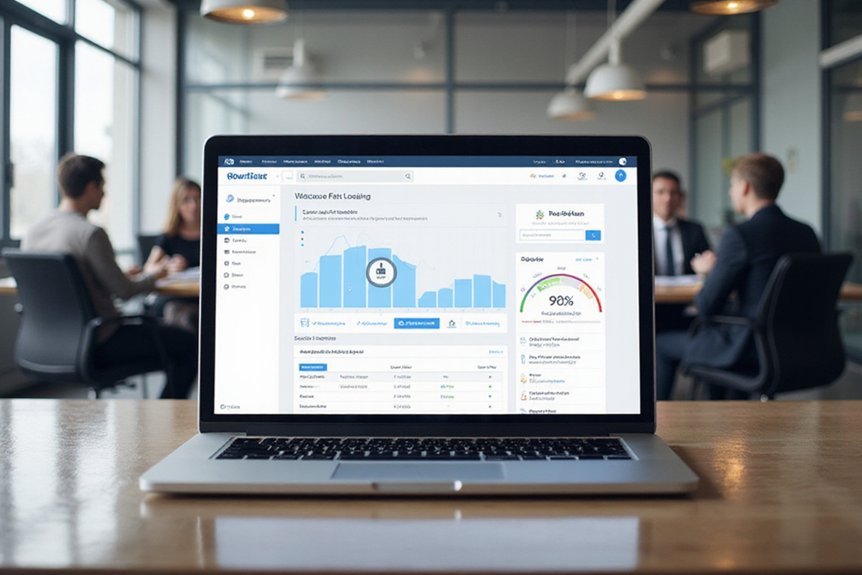Security product landing pages face unique challenges in converting visitors while maintaining credibility. In today’s threat-conscious digital marketplace, organizations must optimize these essential conversion points through strategic implementation of security-focused design elements. Despite significant investments in security solutions, many landing pages inadvertently undermine trust through slow load times, improper badge placement, or ineffective calls-to-action. The following strategies to optimize security product landing pages address these vital shortcomings. They provide measurable performance improvements that extend beyond mere aesthetic enhancements.
Key Takeaways
- Streamline page load times under 2.4 seconds by compressing images and removing render-blocking resources to boost conversions.
- Place security badges and compliance certifications prominently to establish credibility before product evaluation begins.
- Design high-contrast, action-oriented CTAs that emphasize protection benefits at critical decision points in the user journey.
- Implement strategic urgency elements like limited-time security assessments while maintaining professional industry credibility.
- Optimize for mobile with responsive designs, fast loading speeds, and highlighted features like two-factor authentication.
Build Trust With Security-Focused Page Load Optimization

When potential customers visit security product landing pages, their initial interaction with page performance serves as a tangible demonstration of the vendor’s attention to detail, technical competence, and commitment to security principles.
Your landing page speed silently testifies to your technical competence and security commitment.
Optimizing Core Web Essentials, particularly LCP and INP metrics, creates a foundation of trust through performance that inherently communicates reliability. Page load time under 2.4 seconds is crucial for maximizing conversion rates and user engagement. Security vendors must prioritize page speed as a fundamental trust signal, implementing image compression, browser caching, and CDN integration while eliminating render-blocking resources. Faster pages that load in under 2.4 seconds achieve conversion rates nearly twice as high as slower alternatives.
This technical optimization, combined with strategically placed security certifications and compliance badges, establishes credibility before prospects even begin evaluating product features.
Create Conversion-Driven CTAs for Security-Conscious Buyers
Effective calls-to-action represent the culmination of trust-building efforts when you optimize security product landing pages, serving as the critical junction where established credibility transforms into measurable customer action.
When designing CTAs for security-conscious buyers, organizations must implement CTA personalization strategies that dynamically reflect user intent, security concerns, and purchase readiness, thereby creating resonance with specific pain points. Strategic A/B testing can help refine these CTAs to ensure they effectively engage the target audience.
Implementation requires:
- Strategic color contrast that visually separates the CTA from surrounding content
- Action-oriented language that emphasizes protection benefits
- Placement at critical decision points throughout the conversion path
Urgency tactics, such as limited-time security assessments or exclusive access periods, leverage loss-aversion psychology while maintaining the gravitas expected of security solutions.
Striving for a 10% conversion rate or higher should be the goal when optimizing security product landing pages, as this benchmark represents strong performance across industries.
Ultimately, this drives conversion without undermining the brand’s trustworthiness.
Implement Mobile Security Features That Convert
Why do mobile-optimized security features matter so considerably in today’s digital landscape?
Mobile security features have become critical as our digital lives shift increasingly to handheld devices requiring both convenience and protection.
As mobile traffic continues to dominate, security products must adapt their landing pages to accommodate the unique challenges of mobile users, who, despite having shorter attention spans, demand robust protection for their sensitive information. With only 50% of landing pages optimized for mobile devices, security companies have a significant opportunity to outperform competitors in this space. By integrating real-time threat detection capabilities into mobile features, companies can enhance user confidence in their security solutions.
When implementing mobile security features, developers should prioritize:
- Two-factor authentication integration
- Prominent display of mobile encryption capabilities
- Clear communication of user privacy policies
- Streamlined, responsive designs that load within 2.4 seconds
- Dynamic content that converts 25.2% more effectively than static pages
Look into How To Optimize Security Product Landing Pages Today!
In today’s increasingly security-conscious market environment, organizations that implement these optimization strategies—rapid page loading, strategic security badge placement, and conversion-focused CTAs—will demonstrably outperform competitors by establishing trust while simultaneously reducing abandonment rates. Through meticulous attention to both technical performance metrics and psychological trust factors, vendors can optimize security product landing pages that not only communicate value propositions effectively but also convert hesitant prospects into confident customers.

Frequently Asked Questions
How Do Security Trust Badges Affect Conversion Rates?
Security trust badges considerably enhance conversion rates through increased consumer confidence. Studies show up to 42% improvement with strategic trust badge visibility, making them essential for effective conversion rate optimization.
Should We Prioritize Security Certifications or User Testimonials?
Balancing both elements enhances impact. Certification credibility establishes technical authority while testimonial authenticity creates emotional connection. The best approach strategically integrates both based on target audience preferences and decision-making patterns.
What Security Information Should Be Included in Product Comparison Charts?
Product comparison charts should include protection capabilities, detection rates, system impact, feature comparisons, pricing strategies, certification details, real-time threat response, update frequency, cross-platform support, and privacy controls.
How Can A/B Testing Help Optimize Security Product Landing Pages Specifically?
A/B testing identifies ideal security messaging through different variations, revealing which landing page elements—trust badges, feature demonstrations, and CTAs—resonate most effectively with security-conscious visitors, driving higher conversion rates.
What Industry Benchmarks Exist for Security Product Conversion Rates?
Security product conversion rates typically range from 15-18% for cybersecurity SMBs. Industry standards vary by business model—B2C models achieve 18-22%, while B2B models hover between 13-15%, reflecting different purchasing dynamics.



